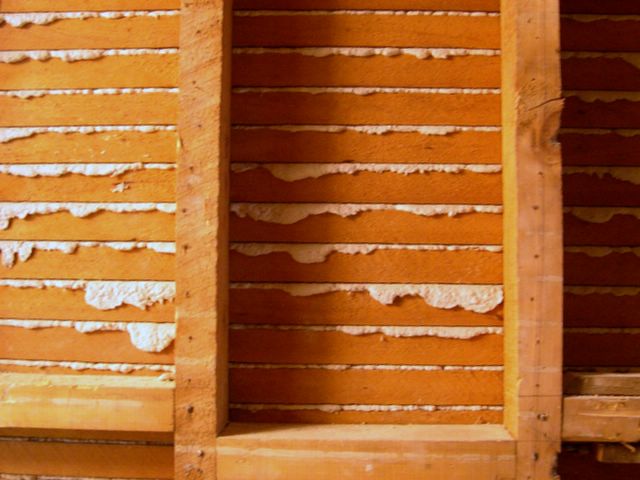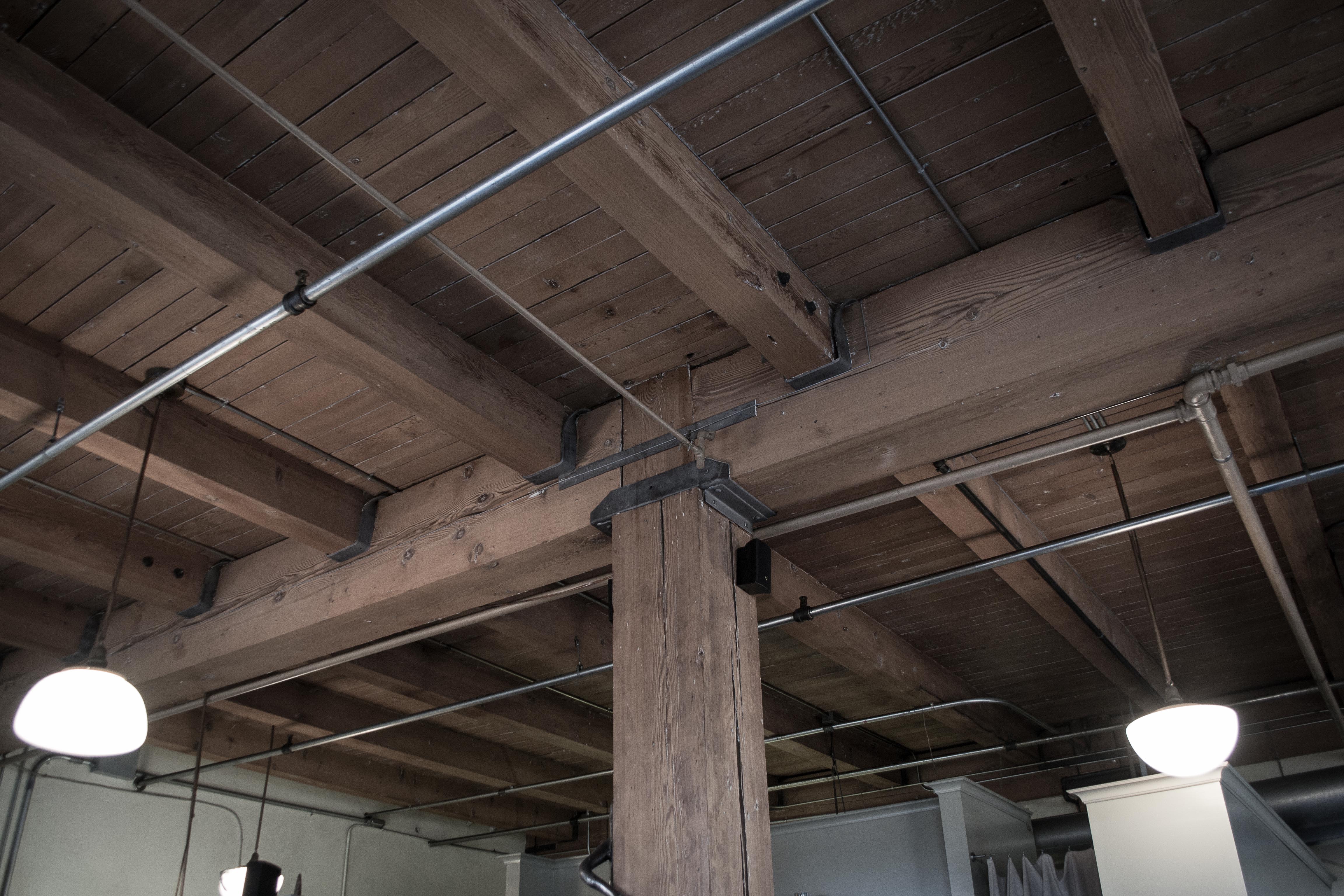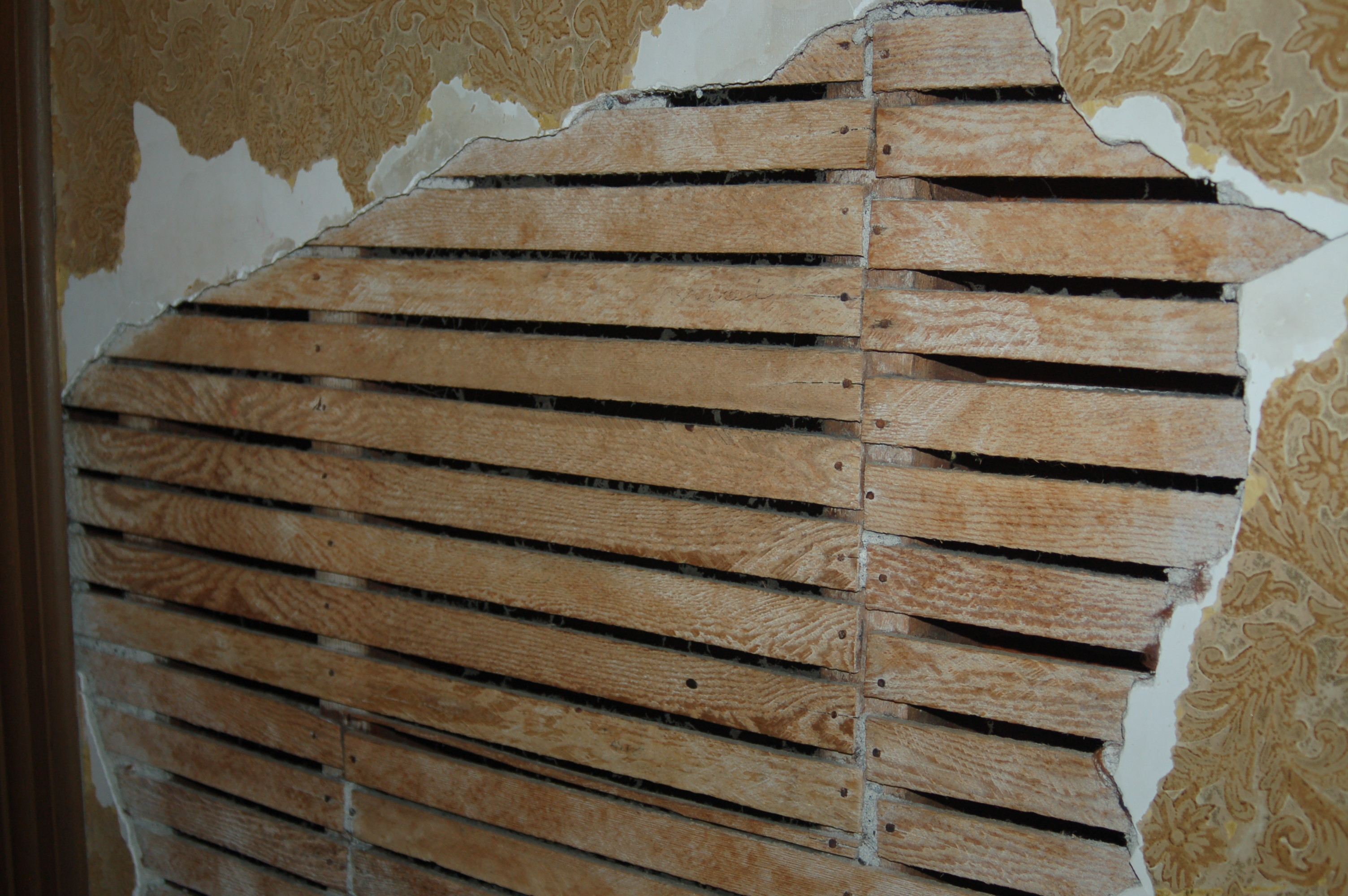|
Reed Mat (plastering)
{{unreferenced, date=October 2008 Reed mat is lathing supplied in a roll. It is made from natural reeds laid parallel, and bound using zinc-plated narrow gauge wire to form a long sheet. Reed mat is suitable for internal use as a base for plastering on walls and ceilings. It can be used against a solid background or over studs or joists as a practical alternative lining material to gypsum plasterboard, clay panel or lath and plaster Lath and plaster is a building process used to finish mainly interior dividing walls and ceilings. It consists of narrow strips of wood (laths) which are nailed horizontally across the wall studs or ceiling joists and then coated in plaster. The .... Reed mats are particularly suited to using with lime, clay or gypsum plasters in building restoration and new-build. External links Reed mat usage Building materials ... [...More Info...] [...Related Items...] OR: [Wikipedia] [Google] [Baidu] |
Lath
A lath or slat is a thin, narrow strip of straight-grained wood used under roof shingles or tiles, on lath and plaster walls and ceilings to hold plaster, and in lattice and trellis work. ''Lath'' has expanded to mean any type of backing material for plaster. This includes metal wire mesh or expanded metal that is applied to a wood or metal framework as matrix over which stucco or plaster is applied, as well as wallboard products called gypsum or rock lath.Ching, Frank. ''A visual dictionary of architecture''. New York: Van Nostrand Reinhold, 1995. 198. Print. Historically, reed mat was also used as a lath material. One of the key elements of lath, whether wooden slats or wire mesh, are the openings or gaps that allow plaster or stucco to ooze behind and form a mechanical bond to the lath. This is not necessary for gypsum lath, which relies on a chemical bond. Etymology The word is recorded from the late 13th century and is likely derived from the Old English word *, ... [...More Info...] [...Related Items...] OR: [Wikipedia] [Google] [Baidu] |
Reed (plant)
Reed is a common name for several tall, grass-like plants of wetlands. Varieties They are all members of the order Poales (in the modern, expanded circumscription), and include: In the grass family, Poaceae * Common reed ('' Phragmites australis''), the original species named reed * Giant reed ('' Arundo donax''), used for making reeds for musical instruments * Burma reed ('' Neyraudia reynaudiana'') * Reed canary-grass ('' Phalaris arundinacea'') * Reed sweet-grass ('' Glyceria maxima'') * Small-reed ('' Calamagrostis'' species) In the sedge family, Cyperaceae * Paper reed or papyrus ('' Cyperus papyrus''), the source of the Ancient Egyptian writing material, also used for making boats In the family Typhaceae * Bur-reed ('' Sparganium'' species) * Reed-mace (''Typha'' species), also called bulrush or cattail In the family Restionaceae * Cape thatching reed (''Elegia tectorum''), a restio originating from the South-western Cape, South Africa. * Thatching reed ('' Thamno ... [...More Info...] [...Related Items...] OR: [Wikipedia] [Google] [Baidu] |
Zinc
Zinc is a chemical element with the symbol Zn and atomic number 30. Zinc is a slightly brittle metal at room temperature and has a shiny-greyish appearance when oxidation is removed. It is the first element in group 12 (IIB) of the periodic table. In some respects, zinc is chemically similar to magnesium: both elements exhibit only one normal oxidation state (+2), and the Zn2+ and Mg2+ ions are of similar size.The elements are from different metal groups. See periodic table. Zinc is the 24th most abundant element in Earth's crust and has five stable isotopes. The most common zinc ore is sphalerite (zinc blende), a zinc sulfide mineral. The largest workable lodes are in Australia, Asia, and the United States. Zinc is refined by froth flotation of the ore, roasting, and final extraction using electricity ( electrowinning). Zinc is an essential trace element for humans, animals, plants and for microorganisms and is necessary for prenatal and postnatal development. It ... [...More Info...] [...Related Items...] OR: [Wikipedia] [Google] [Baidu] |
Plaster
Plaster is a building material used for the protective or decorative coating of walls and ceilings and for moulding and casting decorative elements. In English, "plaster" usually means a material used for the interiors of buildings, while "render" commonly refers to external applications. Another imprecise term used for the material is stucco, which is also often used for plasterwork that is worked in some way to produce relief decoration, rather than flat surfaces. The most common types of plaster mainly contain either gypsum, lime, or cement,Franz Wirsching "Calcium Sulfate" in Ullmann's Encyclopedia of Industrial Chemistry, 2012 Wiley-VCH, Weinheim. but all work in a similar way. The plaster is manufactured as a dry powder and is mixed with water to form a stiff but workable paste immediately before it is applied to the surface. The reaction with water liberates heat through crystallization and the hydrated plaster then hardens. Plaster can be relatively easily worke ... [...More Info...] [...Related Items...] OR: [Wikipedia] [Google] [Baidu] |
Wall Stud
A wall stud is a vertical repetitive framing member in a building's wall of smaller cross section than a post. It is a fundamental element in frame building. Etymology ''Stud'' is an ancient word related to similar words in Old English, Old Norse, Middle High German, and Old Teutonic generally meaning ''prop'' or ''support''."Stud". def. 1. ''Oxford English Dictionary'' Second Edition on CD-ROM (v. 4.0) © Oxford University Press 2009 Other historical words with similar meaning are ''quarter'' and ''scantling'' (one sense meaning a smaller timber, not necessarily the same use). ''Stick'' is a colloquial term for both framing lumber (timber) and a "timber tree" (a tree trunk good for using as lumber (timber)); thus, the names ''"stick and platform"'', ''"stick and frame"'', ''"stick and box"'', or simply ''stick framing''. The stud height usually determines the ceiling height, thus sayings like: "...These rooms were usually high in stud..." Purpose Studs form walls and may carr ... [...More Info...] [...Related Items...] OR: [Wikipedia] [Google] [Baidu] |
Joist
A joist is a horizontal structural member used in framing to span an open space, often between beams that subsequently transfer loads to vertical members. When incorporated into a floor framing system, joists serve to provide stiffness to the subfloor sheathing, allowing it to function as a horizontal diaphragm. Joists are often doubled or tripled, placed side by side, where conditions warrant, such as where wall partitions require support. Joists are either made of wood, engineered wood, or steel, each of which has unique characteristics. Typically, wood joists have the cross section of a plank with the longer faces positioned vertically. However, engineered wood joists may have a cross section resembling the Roman capital letter ""; these joists are referred to as -joists. Steel joists can take on various shapes, resembling the Roman capital letters "C", "", "L" and "S". Wood joists were also used in old-style timber framing. The invention of the circular saw for use in m ... [...More Info...] [...Related Items...] OR: [Wikipedia] [Google] [Baidu] |
Plasterboard
Drywall (also called plasterboard, dry lining, wallboard, sheet rock, gypsum board, buster board, custard board, and gypsum panel) is a panel made of calcium sulfate dihydrate (gypsum), with or without additives, typically extruded between thick sheets of facer and backer paper, used in the construction of interior walls and ceilings. The plaster is mixed with fiber (typically paper, glass wool, or a combination of these materials); plasticizer, foaming agent; and additives that can reduce mildew, flammability, and water absorption. In the middle of the 20th century, drywall construction became prevalent in North America as a time- and labor-saving alternative to lath and plaster. History The first plasterboard plant in the UK was opened in 1888 in Rochester, Kent. Sackett Board was invented in 1894 by Augustine Sackett and Fred Kane, graduates of Rensselaer Polytechnic Institute. It was made by layering plaster within four plies of wool felt paper. Sheets were thick with ... [...More Info...] [...Related Items...] OR: [Wikipedia] [Google] [Baidu] |
Clay Panel
Clay panel or clay board (also known as ''loam panel'', ''clay wallboard'', ''clay building board'', or ''clay building panel'') is a panel made of clay with some additives. The clay is mixed with sand, water, and fiber, typically wood fiber, and sometimes other additives like starch. Most often this means employing the use of high-cellulose waste fibres. To improve the breaking resistance clay boards are often embedded in a hessian skin on the backside or similar embeddings. By introducing the clay panels, the building material loam can also be used in dry construction. Clay wallboards are a sustainable alternative to gypsum plasterboards, suitable for drywall applications for interior walls and ceilings. It can be applied to either timber or metal studwork. Usually the application of clay boards is completed with clay finishing plaster. Constructional properties The boards have fire retardant properties and medium levels of acoustic insulation. Due to the clay component the ... [...More Info...] [...Related Items...] OR: [Wikipedia] [Google] [Baidu] |
Lath And Plaster
Lath and plaster is a building process used to finish mainly interior dividing walls and ceilings. It consists of narrow strips of wood (laths) which are nailed horizontally across the wall studs or ceiling joists and then coated in plaster. The technique derives from an earlier, more primitive process called wattle and daub. Lath and plaster largely fell out of favour in the U.K. after the introduction of plasterboard in the 1930s.Jeff Howell''On the level: is the old plaster best?'' The Telegraph (London), May 10, 2006. Retrieved 2012-03-30. In Canada and the United States, wood lath and plaster remained in use until the process was replaced by transitional methods followed by drywall (the North American term for plasterboard) in the mid-twentieth century. Description The wall or ceiling finishing process begins with wood or metal laths. These are narrow strips of wood, extruded metal, or split boards, nailed horizontally across the wall studs or ceiling joists. Each wall f ... [...More Info...] [...Related Items...] OR: [Wikipedia] [Google] [Baidu] |
Lime Plaster
Lime plaster is a type of plaster composed of sand, water, and lime, usually non-hydraulic hydrated lime (also known as slaked lime, high calcium lime or air lime). Ancient lime plaster often contained horse hair for reinforcement and pozzolan additives to reduce the working time. Traditional non-hydraulic hydrated lime only sets through carbonatation when the plaster is kept moist and access of CO2 from the air is possible. It will not set when submersed in water. When a very thick layer or several layers are applied, the lime can remain soft for weeks. The curing time of lime plaster can be shortened by using (natural) hydraulic lime or adding pozzolan additives, transforming it into artificially hydraulic lime. In ancient times, Roman lime plaster incorporated pozzolanic volcanic ash; in modern times, fly ash is preferred. Non-hydraulic lime plaster can also be made to set faster by adding gypsum. Lime production for use in plastering home-made cisterns (in making them ... [...More Info...] [...Related Items...] OR: [Wikipedia] [Google] [Baidu] |







